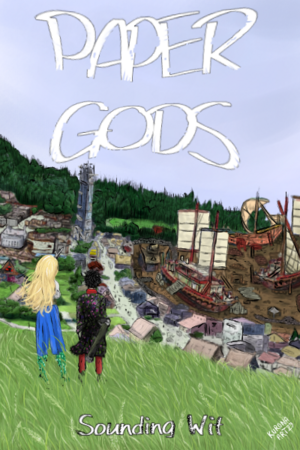Chapter 2:
Chapter 2 - The Discovery
If Bones Could Talk
“Captain,” Peretti's Legacy’s intelligent computer said with a soft voice. “I think I have something you might be interested in.”
Captain Balmar stirred in his chair. “What is it, Torque?” he asked, turning his head to look at the large screen to his left. It was filled with a myriad of dots and symbols, each representing an inactive comet they were charting. At the far end of the screen, one of the dots was blinking.
“I’ve noticed an anomalous reading in the gravity field mapping,” the computer explained. “Object 256709QED appears to be significantly denser than expected.”
That was interesting indeed, Captain Balmar thought. The field generator onboard the Legacy wasn’t just able to manipulate local gravity gradients; it could also detect how the existing gradients farther out interacted with the modified local gravity field, effectively turning it into a very precise gravity detector. This had been the crew's main tool for the past four months to detect unknown cometary bodies out here in the belt. Even in this comparatively dense region of the star system, the mean distances between comets were still measured in millions of kilometers. If you simply looked out the window, you’d never even know you were smack in the middle of a cometary belt. But to the computer controlling the field generator, the small masses of these tiny celestial bodies stood out against the flatter gravity gradient of interplanetary space like fireworks in the sky.
Given that comets typically don’t generate artificial gravity, these readings correlated directly to the mass of the objects they were surveying. If you knew the mass and volume, you could easily determine the density of the unknown object.
The problem was, of course, they didn’t know the volume.
“What makes you say that?” he asked, feeling both confused and excited at the same time.
The computer responded without delay. “I’m mostly just guessing,” it admitted. “Call it a gut feeling. But most of the comets in this part of the belt are fragments, typically less than half a kilometer in length. If I assume this object has a similar size, I can make an educated guess of its density. And it’s way higher than I expected.”
Captain Balmar mused on that for half a minute before speaking again. “Either that, or the object is much larger than those we typically run into here,” he concluded.
“It might be,” Torque admitted. If it was offended by the captain questioning its reasoning, its voice didn’t betray those feelings in the slightest. “If it’s that large, we might even be able to spot it visually.”
“Alright, here’s what we’ll do.” Balmar wasn’t fully convinced this warranted their attention yet, but looking wouldn’t cost them much. “Retask the 80 cm Cassegrain to observe the object. If you can’t see it with that, we’ll take the ship in for a closer look.”
“Sounds like a good plan, Captain,” the computer said. “I’ll let you know what I see.”
* * *
Thirty minutes later, Peretti's Legacy was on the move. As the computer had expected, the object had remained invisible, proving it was small enough to make its comparatively large mass anomalous. In other words, whatever was out there was made of metal, not ice. And an object made of metal could only mean one thing: it was a ship. If it turned out to be abandoned, it could be salvaged, providing the crew with a much needed secondary source of income.
As the Legacy drifted closer to the unknown ship, some of the crew started to gather in the observation lounge. At first, the telescope image on the screen showed nothing more than a dot of light, but as the distance decreased, details began to emerge. It was a large and elongated ship, perhaps half a kilometer from bow to stern. The damage it had sustained—large parts of its side ripped open—made it clear it was indeed abandoned.
“There is no radio beacon active on the wreck,” Torque informed them after listening through the radio spectrum for several minutes. “And I can’t match the visual profile of the ship with any known models produced by the Terran Federation.”
So it was alien, Captain Balmar thought. He wasn’t exactly surprised. If the Sunguard or any other contractor working for it had lost such a large ship in this system, chances were they’d have heard about it by now. The question was, which of the alien races in the vicinity had had a reason to visit the Gliese 556 system?
“Alright,” he commanded the computer. “Extend the search to ships produced by all races encountered during the Second Expansion.”
That would probably take some time, as those records weren’t kept onboard. But the search should cover every known type of ship made within 50 light-years. If that didn't come up with a match—well, then, this was big news indeed. And big news meant big money, if they played their cards right. Captain Balmar was starting to feel excited. Looking around at the gathered crew, he could see it was a feeling shared by the women and men he employed.
Twenty minutes later, they had their answer.
“Sorry it took so long, Captain,” the intelligent computer said apologetically. “The Sonmai database wasn’t publicly available. I had to buy access first, and it took a little time to negotiate a reasonable price with the seller. Incidentally, I had to pay them with my own private funds, so I expect you’ll reimburse me once we’ve salvaged the ship, eh?”
“Sure, Torque,” Balmar answered absentmindedly. The added expense of a few terabytes of hyperspace database access was nothing compared to the money they were about to make here.
“Thank you, Captain,” Torque said, the relief audible in its voice.
“Well,” it continued, “you’ll be happy to know that I couldn’t find a match to the ship’s profile in any of the databases. It’s not just alien—it’s from a civilization the Terran Federation hasn’t yet encountered.”
“We need to report it,” his first mate interjected. She was a Terran woman in her early thirties, with short blond hair and gray eyes that missed nothing.
“Not yet,” Captain Balmar cautioned. “If we report it now, the Sunguard will just waltz in here and take over, and we won’t get more than a finder’s fee. Maybe not even enough to cover our losses from delaying the survey mission. I’m sure Special Agent Watanabe and his men will be all over the wreck in a matter of hours once we tell the Federation about it. That doesn’t give us much time to remove artifacts from it before the military moves in. The longer we wait, the more parts we can sell off first.”
He knew what he was talking about. In a previous career, he had made a killing selling cars he had… acquired. And it had always been a better deal to chop them up and sell them in parts rather than just finding a single buyer for the whole vehicle. Captain Balmar was certain the same would be true here.
By now, they were close enough to the alien ship to be able to see it with their own eyes. Captain Balmar noticed his ground sample specialist, an older Kelar male with shoulder length black hair, standing close to the large observation window, seemingly deep in thought.
“What is it, Plav-tor-fel-mak?” he asked. “You’re seeing something I don’t?”
The small, blue lizard turned around to face the hairy Jerrassian. There was a look on his scaly face that, at first, seemed like concern but upon closer inspection was more akin to contemplation.
“The ship is old, Captain, bless your fur,” Plav-tor-fel-mak said. “See the shape of it? The curves? It’s majestic. Beautiful.”
Balmar wasn’t surprised that was what the specialist had focused on. The Kelar had always had an eye for beauty. Captain Balmar imagined the tough little man was sitting in his cabin making clay sculptures of weeping children, or something like that, when he wasn’t out roughing it with the rest of the crew. Balmar didn’t mind that in the slightest—having a crew member with an eye for the finer things had been to their benefit—and to the Sunguard’s detriment—more than once.
“But no one builds a beautiful ship for their first expedition into interstellar space. Or their second, for that matter,” Plav-tor-fel-mak continued. “Just look at our own ships. We’ve been flying between the stars for five hundred years now—the Etarians, bless their heads, a few centuries more than that, even—and yet our ships are still ugly, functional monstrosities. Boxy or cylindrical, without any beauty to them at all. You don’t spend the resources making your ships look aesthetically pleasing until you’re confident you’ve first mastered interstellar flight.”
Captain Balmar turned his head to take a second look at the ship. Though not an artist himself, he could certainly see what the specialist meant. Despite the damage to the hull, it was clear whoever had built the alien ship had spent considerable effort on its looks. If this wasn’t the result of an accident that had befallen an early expedition of theirs but rather a disaster striking a race that had been traveling between the stars for millennia, it could only mean one thing: the ship was old, and the race that had built it even older. In all likelihood, it predated all the known civilizations by a thousand years or more.
It all made Captain Balmar even more certain he was right in his decision to explore the wreck before reporting it to the Terran Federation.
Author's Note
The story you're reading is one of many set in the Lords of the Stars universe I've been creating over the past 30 years, where familiar characters and places reappear, and new favorites await discovery. Check out my profile to explore more stories from this universe.
If you liked this chapter, please consider giving it a like.
Visit the official Lords of the Stars blog for more information about this hard sci-fi universe: https://lordsofthestars.wordpress.com




Please sign in to leave a comment.